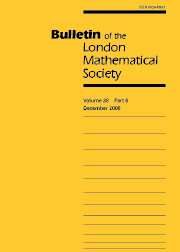Crossref Citations
This article has been cited by the following publications. This list is generated based on data provided by
Crossref.
Fulman, Jason
2000.
A Probabilistic Approach to Conjugacy Classes in the Finite Symplectic and Orthogonal Groups.
Journal of Algebra,
Vol. 234,
Issue. 1,
p.
207.
Fulman, Jason
2001.
Random matrix theory over finite fields.
Bulletin of the American Mathematical Society,
Vol. 39,
Issue. 1,
p.
51.
Fulman, Jason
2002.
Finite Affine Groups: Cycle Indices, Hall–Littlewood Polynomials, and Probabilistic Algorithms.
Journal of Algebra,
Vol. 250,
Issue. 2,
p.
731.
Chapman, Robin
2005.
A probabilistic proof of the Andrews–Gordon identities.
Discrete Mathematics,
Vol. 290,
Issue. 1,
p.
79.
Ole Warnaar, S.
2006.
Hall–Littlewood functions and the A2 Rogers–Ramanujan identities.
Advances in Mathematics,
Vol. 200,
Issue. 2,
p.
403.
Coskun, Hasan
2010.
Multiple analogues of binomial coefficients and families of related special numbers.
Discrete Mathematics,
Vol. 310,
Issue. 17-18,
p.
2280.
Lengler, Johannes
2010.
The Cohen–Lenstra heuristic: Methodology and results.
Journal of Algebra,
Vol. 323,
Issue. 10,
p.
2960.
Wang, Mingjin
2010.
A new probability distribution with applications.
Pacific Journal of Mathematics,
Vol. 247,
Issue. 1,
p.
241.
Wang, Mingjin
2011.
An expectation formula with applications.
Journal of Mathematical Analysis and Applications,
Vol. 379,
Issue. 1,
p.
461.
Chu, W.
and
Wang, C.
2012.
Iteration process for multiple rogers–ramanujan identities.
Ukrainian Mathematical Journal,
Vol. 64,
Issue. 1,
p.
110.
WANG, MINGJIN
2013.
PROBABILISTIC DERIVATION OF A q-POLYNOMIALS TRANSFORMATION FORMULA.
Infinite Dimensional Analysis, Quantum Probability and Related Topics,
Vol. 16,
Issue. 02,
p.
1350017.
Liu, Xian-Fang
Bi, Ya-Qing
and
Luo, Qiu-Ming
2014.
New Proofs of Someq-Summation andq-Transformation Formulas.
The Scientific World Journal,
Vol. 2014,
Issue. ,
p.
1.
Wang, Mingjin
2014.
A PROBABILISTIC VERSION OF MEHLER'S FORMULA.
Taiwanese Journal of Mathematics,
Vol. 18,
Issue. 2,
Griffin, Michael J.
Ono, Ken
and
Warnaar, S. Ole
2016.
A framework of Rogers–Ramanujan identities and their arithmetic properties.
Duke Mathematical Journal,
Vol. 165,
Issue. 8,
Fulman, Jason
2016.
Hall-Littlewood Polynomials and Cohen-Lenstra Heuristics for Jacobians of Random Graphs.
Annals of Combinatorics,
Vol. 20,
Issue. 1,
p.
115.
Wang, Mingjin
2017.
A new discrete probability space with applications.
Journal of Mathematical Analysis and Applications,
Vol. 455,
Issue. 2,
p.
1733.
Wang, Mingjin
2019.
An Expectation Formula Based on a Maclaurin Expansion.
Taiwanese Journal of Mathematics,
Vol. 23,
Issue. 3,
Assiotis, Theodoros
2021.
Infinite 𝑝-adic random matrices and ergodic decomposition of 𝑝-adic Hua measures.
Transactions of the American Mathematical Society,
Vol. 375,
Issue. 3,
p.
1745.
Fulman, Jason
and
Guralnick, Robert
2022.
Cohen Lenstra partitions and mutually annihilating matrices over a finite field.
Linear Algebra and its Applications,
Vol. 645,
Issue. ,
p.
1.
Schlosser, Michael
2023.
Bilateral identities of the Rogers–Ramanujan type.
Transactions of the American Mathematical Society, Series B,
Vol. 10,
Issue. 31,
p.
1119.




